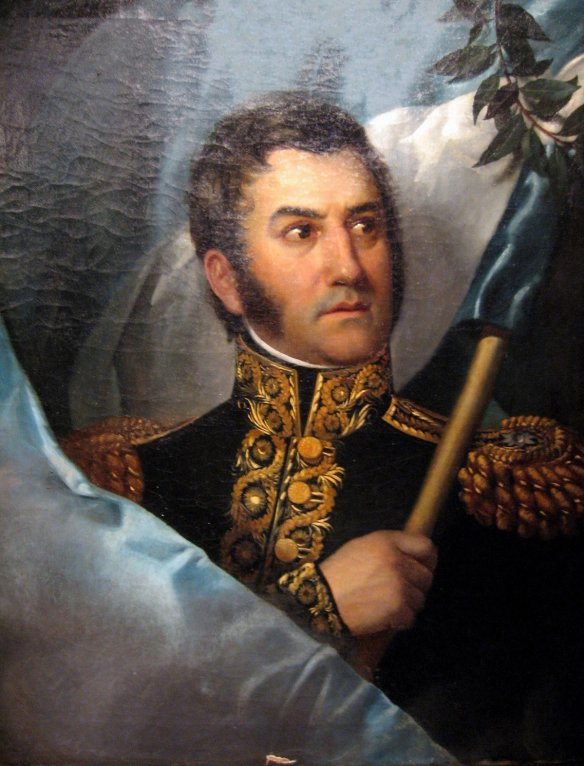In 1812, José de San Martin returned to the land of his birth, Argentina, after a career as an army officer fighting in Spain against the French occupation. His Spanish father had been a career officer in the colonies, stationed at Yapeyu on the Uruguay River, where San Martin was born. On his return from Europe, San Martin offered his services to the various governments at Buenos Aires and avoided participation in the political intrigue of the old viceregal capital. He reorganized the porteño army, then took command of the patriot forces in the interior. In 1816, he and his army defeated a loyalist invasion sent across the Andes from Lima.
San Martin identified Lima as the key to securing independence in South America, for the viceroy in this royalist stronghold had sent military expeditions to put down rebellions in Ecuador, Bolivia, and Chile, as well as in Argentina. Not even Argentina would be secure in its newly declared independence so long as Spanish forces remained in Lima. He decided that the surest way to eliminate this Spanish bastion was through Chile; therefore, he established headquarters at Mendoza, where San Martin trained an expeditionary army composed of Argentines and Chilean exiles.
The majority of his force, especially the foot soldiers, consisted of persons of color. San Martin requisitioned slaves from the local gentry, giving them their freedom on condition that they fight for the cause of independence. Eventually, 1,500 slaves entered his army. Under his command, the blacks, mulattoes, and mestizos formed a disciplined fighting force and did not engage in the sort of pillage that characterized other military units of the period. “The best infantry soldiers we have are the Negroes and mulattoes,” said one of San Martin’s staff officers. “Many of them rose to be good non-commissioned officers” (Lynch 2009, 88). Exiled Chilean patriots led by Bernardo O’Higgins contributed another important element to this expeditionary force.
General San Martin executed a great military feat in safely leading his 5,000 troops across the Andes Mountains. He misled the royalists as to his route and reassembled three columns of his troops in time to defeat a divided Spanish force (led by General Marco del Pont, brother of the Spanish merchant exiled from Buenos Aires) at Chacabuco in February 1817. His troops then liberated the Chilean capital of Santiago. Two more battles ensued, and San Martin decisively defeated the remaining Spanish forces at Maipú in April. With Chile liberated and now ruled firmly but not ruthlessly by O’Higgins, San Martin laid the strategy for the next continental move. He hired a British admiral, Lord Cochrane, to organize a patriot navy for the expedition. San Martin formed up a new army, now of Chileans, Argentines, and Peruvian patriots, but was without a Peruvian leader of the stature of O’Higgins in Chile. Again, slaves enlisted in his army and were subjected to military discipline in exchange for their eventual freedom. Chile levied special taxes to support the new patriot army, just as the citizens of Mendoza had supported the liberation of Chile. In 1820, 23 ships carrying a patriot army of 4,500 soldiers set sail for Lima.
The campaign in Peru did not unfold according to plan, however. San Martin disembarked his troops at Pisco, 125 miles south of Lima, and sent the fleet on to blockade the port of Callao. His patriot column then marched north, circling around the viceregal capital of Lima and setting up a headquarters at Huacho. San Martin’s presence sparked guerrilla activities in the sierra, but the Creole aristocracy of Lima, on whom the Argentine general had relied for some demonstration of support, did nothing. Rather than confront San Martin in battle, the Spanish forces proceeded to negotiate. Finally, in 1821, they evacuated Lima and relocated to the highlands as San Martin entered Lima. The Creoles professed to be pleased but were also dismayed that the bandits and brigands, many of them free blacks and runaway slaves who had made travel outside the capital so perilous, were now joining San Martin’s patriot troops.
In the absence of a united Creole government, San Martin had to accept political leadership. The citizens of Lima may have been motivated more by public security than by making sacrifices for the liberation of Peru. They developed a widespread fear of the troops of San Martin. According to an English observer, “It was not only of the slaves and of the mob that people were afraid, but with more reason of the multitude of armed Indians surrounding the city, who, although under the orders of San Martin’s officers, were savage and undisciplined troops” (Lynch 1987, 68). It was not lost on the local landowners that their own control of the slaves was undermined by the fact that many of San Martin’s troops were former African slaves as well as free blacks. Moreover, San Martin levied special taxes to support his troops, which made him unpopular with the residents of Lima, the limeños.
San Martin’s problems were numerous. The general hesitated to risk his army in confronting the enemy, who could gather twice the number of troops as he could. He was also receiving little assistance from the Peruvians. Moreover, as provisional governor, he alienated many Peruvian Creoles by enlisting their slaves into military service, decreeing a law that freed the children born to slaves, and outlawing Indian tribute and forced labor. The Creoles would not rise to his revolution, and by 1822, San Martin was ready to look for another solution.
